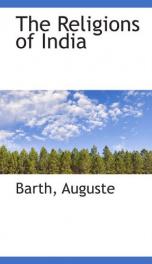the religions of india

Purchase of this book includes free trial access to www.million-books.com where you can read more than a million books for free. This is an OCR edition with typos. Excerpt from book: IL BRAHMANISM. I. RITUAL. Gradual extension and general character of the religion of the Atharva- Veda, the Yajur-Veda and the Brahmanas.Changes introduced into the pantheon.Still greater changes in the spirit and institutions. The Brahman a member of a caste.Formation of a sacred language and literature.The Brahmacarya and the JLSrahnianical schools. Ritualism and formalism : the rites come to the foreground and the gods retire into the shade.Sketch of the cultus according to the Brahmanas and the Sutras.The Grihya ritual: the ancient Smriti and the Dharma.The Crauta ritual: ishti and somayaga.Aristocratic, expensive, and blood)' character of this worship : animal sacrifice ; human sacrifice ; the anumarana, or the suicide of the widow. The authorised religion of the Brahmaus recognised neither images nor sanctuaries. Propagated, its exclusive spirit notwithstanding, among foreign races, in the Dekhan, and as far as the Sunda Islands : the Veda at Bali. The geographical region of the Hymns extends from the valley of Cabul to the banks of the Ganges, and perhaps beyond; but the true country of their birth, that in regard to which they supply the most data, is the Punjab.1 In the age that follows, which we have now reached, we see the religions of the Veda advancing eastward, and gradually taking possession of the vast and fertile plains of Hindustan. From the epoch of the Brahmanas their centre is no longer in the basin of the Indus, the tribes of whichare, on the contrary, regarded with mistrust;1 but on the Sarasvati, in the Doab, between the Jumna and the Ganges, and even farther east, on the Gomati and the Gogra. On the east and south they came into contact with the tribes which inhabit the shores of the Eastern Sea and the other side of the Vindhya mo...
Info about the book
Author:
Series:
Unknown
ISBN:
1177021730
Rating:
3.5/5 (2)Your rating:
0/5
Languge:
English
Users who have this book
Users who want this book
What readers are saying
What do you think? Write your own comment on this book!
write a commentGenre
if you like the religions of india try:
Other books by this author
Do you want to read a book that interests you? It’s EASY!
Create an account and send a request for reading to other users on the Webpage of the book!


